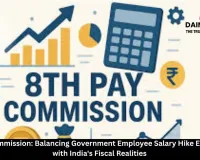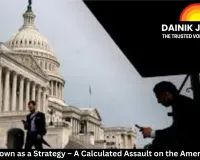India's Debt Mirage: How Rs.200 Lakh Crore Burden Stifles True Progress
Digital Desk

In a nation aspiring to superpower status, the latest fiscal bombshell couldn't be more ironic: India's government debt is barreling toward a staggering Rs.200 lakh crore by 2030, according to recent projections from the Reserve Bank of India.
Dubbed the "hallucination of progress" by economists, this mountain of borrowing isn't just numbers on a balance sheet it's a ticking time bomb eroding the very foundations of sustainable development.
As headlines scream of GDP miracles and stock market highs, it's time to peel back the gloss and confront how this debt-driven growth model is nothing short of a Faustian bargain, trading long-term prosperity for short-term illusions.
At its core, debt-fueled expansion promises quick wins: infrastructure booms, urban skylines piercing the clouds, and highways snaking through rural heartlands.
Yet, this model undermines real development in insidious ways. When governments lean on loans to pump-prime the economy, they prioritize visible megaprojects over the invisible scaffolding of human capital.
Education budgets languish, healthcare crumbles under underfunding, and social safety nets fray at the edges. Recall the 2024-25 Union Budget: a paltry 2.5% allocation for health amid a post-pandemic reckoning, while capital expenditure on roads and ports soared to Rs.11 lakh crore.
This isn't growth; it's a veneer. True development, as Amartya Sen's capability approach reminds us, hinges on empowering people not just building bridges they can't afford to cross.
Worse, this borrowing spree inflates asset bubbles, widening the chasm between the elite and the everyman. Household debt has surged 40% in the last five years, per RBI data, as families chase the dream of upward mobility in a rigged game.
Small businesses, the lifeblood of India's 1.4 billion-strong economy, drown in high interest rates while big corporates feast on low-cost credit. The result? A vicious cycle where public debt servicing—projected to gobble 25% of revenues by 2028—squeezes out investments in agriculture, where 45% of our workforce toils.
Farmers, already battered by climate whims and market volatility, see subsidies slashed to service yesterday's loans. Is this progress, or a pyramid scheme where the base crumbles while the apex gleams?
The critique deepens when we zoom in on policy favoritism: a blatant tilt toward corporations over citizens' welfare. Tax breaks for billion-dollar conglomerates, like the Rs.1.5 lakh crore in corporate incentives last fiscal year, are sold as job creators.
But where are the jobs? Unemployment hovers at 8%, youth disillusionment festers, and gig workers scrape by without protections. Meanwhile, schemes like Ayushman Bharat limp along with inadequate funding, leaving millions exposed to medical bankruptcies.
This isn't trickle-down economics; it's a deliberate drip-feed to the powerful. Policies like the Goods and Services Tax (GST) regime, while streamlining for businesses, have disproportionately burdened small traders and the poor through regressive compliance costs. Why favor faceless boardrooms when 70% of GDP stems from informal sectors crying for social investment?
India's tryst with debt-driven growth echoes Greece's 2010s meltdown or Argentina's perennial defaults nations seduced by easy money, only to wake up shackled. To break free, we need a paradigm shift: fiscal prudence that channels borrowings into human-centric assets like skill training and universal basic services.
Redirect corporate sops toward green jobs and rural innovation; enforce progressive taxation that claws back from the ultra-rich. Leaders must heed the "hallucination" warning progress isn't measured in borrowed billions but in lives uplifted.
As we hurtle toward 2047's centenary dreams, let's demand real development over illusory highs. The Rs.200 lakh crore cliff awaits; will we leap blindly, or build a safer path? The choice is ours, before the debt collectors come knocking.





.jpg)

.jpg)

.jpg)
